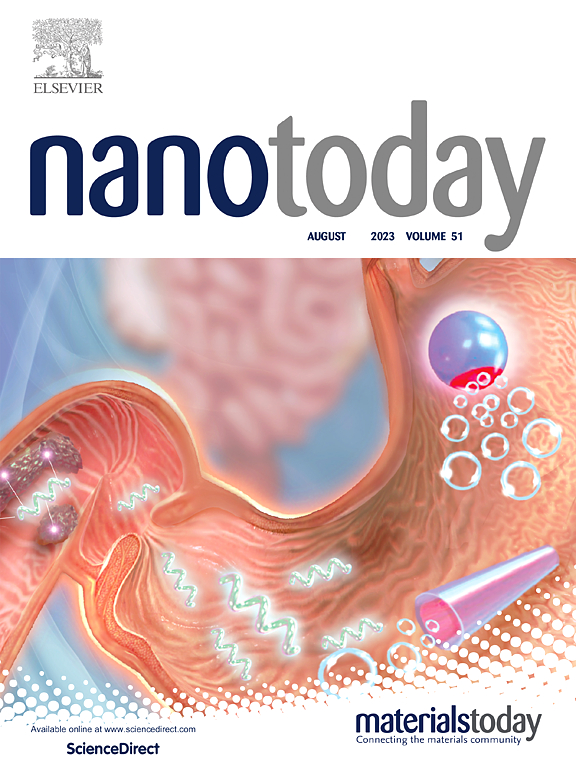Engineered organoid precursor with micro-nano materials for boosting nucleus pulposus reconstruction after discectomy
IF 10.9
1区 材料科学
Q1 CHEMISTRY, MULTIDISCIPLINARY
引用次数: 0
Abstract
Nucleus pulposus (NP) discectomy is a clinical procedure used to treat late-stage intervertebral disc degeneration. Although it can relieve pain symptoms, self-repair and regeneration of the NP tissues cannot be realized due to low regenerative capacity and inhibitory microenvironment. Here, we develop an engineered NP organoid precursor (OP) to reconstruct severely defective NP tissues, which is self-assembled and induced from bone marrow mesenchymal stem cells with functional micro-nanomaterials. Decellularized extracellular matrix microparticles from NP provide biomimetic matrix structure and enriched active ingredients to enhance the survival and chondrogenic differentiation of bone marrow mesenchymal stem cells. Commodified with transforming growth factor -β3, titanium carbide nanozyme with high reactive oxygen species scavenging capacity, exhibiting dual pro-differentiation and anti-inflammatory functions. The total integration of these functional components into 3D cell spheroid induces the formation of OP resembling certain structures and functions of the natural NP, as well as microenvironmental regulatory capabilities. In the rat nucleotomy model, the injection of pre-differentiated NP-OP significantly alleviates oxidative stress and inflammation, maintains disc height and water content, and accelerates new extracellular matrix deposition, thus promoting effective NP reconstruction. Overall, this engineered NP-OP provides a promising therapeutic approach for severe intervertebral disc degeneration.
微纳材料工程类器官前体促进椎间盘切除术后髓核重建
髓核椎间盘切除术是一种用于治疗晚期椎间盘退变的临床手术。虽然能缓解疼痛症状,但由于再生能力低和微环境的抑制,NP组织无法实现自我修复和再生。在这里,我们开发了一种工程NP类器官前体(OP)来重建严重缺陷的NP组织,该组织是由骨髓间充质干细胞与功能微纳米材料自组装和诱导的。NP脱细胞细胞外基质微颗粒具有仿生基质结构和丰富的活性成分,可促进骨髓间充质干细胞的存活和软骨分化。碳化钛纳米酶与转化生长因子-β3商品化后,具有较高的活性氧清除能力,具有促分化和抗炎双重功能。这些功能成分全部整合到三维细胞球体中,形成了类似于天然NP的某些结构和功能的OP,并具有微环境调节能力。在大鼠核切除模型中,注射预分化NP- op可显著缓解氧化应激和炎症,维持椎间盘高度和含水量,加速新的细胞外基质沉积,从而促进有效的NP重建。总的来说,这种工程化的NP-OP为严重椎间盘退变提供了一种有希望的治疗方法。
本文章由计算机程序翻译,如有差异,请以英文原文为准。
求助全文
约1分钟内获得全文
求助全文
来源期刊

Nano Today
工程技术-材料科学:综合
CiteScore
21.50
自引率
3.40%
发文量
305
审稿时长
40 days
期刊介绍:
Nano Today is a journal dedicated to publishing influential and innovative work in the field of nanoscience and technology. It covers a wide range of subject areas including biomaterials, materials chemistry, materials science, chemistry, bioengineering, biochemistry, genetics and molecular biology, engineering, and nanotechnology. The journal considers articles that inform readers about the latest research, breakthroughs, and topical issues in these fields. It provides comprehensive coverage through a mixture of peer-reviewed articles, research news, and information on key developments. Nano Today is abstracted and indexed in Science Citation Index, Ei Compendex, Embase, Scopus, and INSPEC.
 求助内容:
求助内容: 应助结果提醒方式:
应助结果提醒方式:


